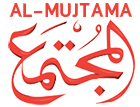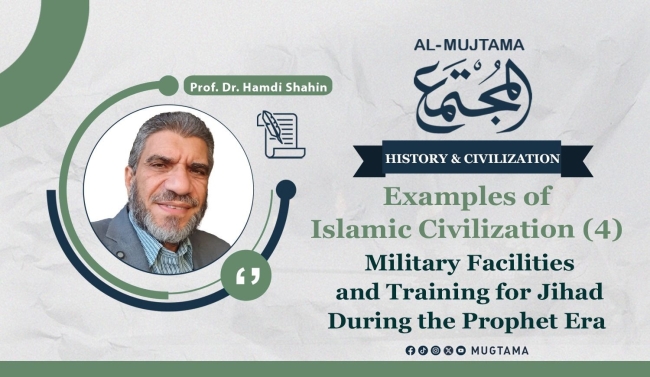Military Facilities and Training for Jihad During the Prophet Era
In the early days, Muslims paid exceptional attention to military facilities and jihad training, as they were establishing a state, carrying a religious message, striving to fulfill a divine promise of victory and empowerment, and living in a continuous state of military action; either confronting aggression or initiating conquests. In both cases, they faced with superiority changes in topography, climate, and combat methods, and they employed various factors to achieve their goals.
In this article, we discuss an aspect of military facilities and training in Medina during the time of the Prophet, which laid the foundations and provided a model for what followed.
Fortresses and forts.
Al-atm is the fortress, or it is the high construction like the fortress.(1) The walls were the pride of the people of the Prophet's city, which they cherished, and they provided protection from their enemies.(2) In an Arab environment where raids were a common occurrence, whether for a justified reason or for no reason .
The city was an oasis of goodness amidst a barren surrounding, which represented an allure for the Bedouin tribes around it to raid it, seeking to seize its wealth and the riches of its people. Additionally, enmities had deepened among its own inhabitants, including Arabs and Jews, as well as between the Arab tribes of Aws and Khazraj, and among the Jewish tribes and their Arab allies; both Aws and Khazraj. Thus, the call for fortification and caution became both sufficient and imperative.
The Jews built 59 fortresses, and the Arabs who settled there before Islam built 13 fortresses.(1) Some Arab tribes fortified themselves extensively, to the extent that the Banu Bayadah of the Khazraj had 19 forts in their area. Some of the forts in the city became well-known, and the region where they were built became named after these forts, such as Sanhuhrah and Aqim. Some were named after the tribe or the builders, such as the fort of Al-Zubair ibn Batta, Malik ibn Al-Ajlan, and Malik ibn Sinan, the father of Abu Sa'id Al-Khudri, may Allah be pleased with him.
And how their poets take pride in those fortresses and their grandeur.
When the migration to Medina took place, the Messenger of Allah, peace be upon him, forbade the destruction of the fortifications of the city, saying: 'Do not demolish the fortifications because they are the adornment of the city.(4) The Ansar built a new fort, bringing the total number of forts in the city to one hundred and twenty.(5) The Muslims benefited from these fortifications during their struggles in the time of the Prophet Muhammad (peace be upon him). In the Battle of the Trench, the Prophet (peace be upon him) led 3,000 men until their backs were against Mount Sal, and he set up his camp, placing the trench between himself and the enemy. He commanded that the children and women be placed in the strongholds, which served as a source of security for them during this difficult time, which Allah described with His words:( Remember˺ when they came at you from east and west,1 when your eyes grew wild ˹in horror˺ and your hearts jumped into your throats, and you entertained ˹conflicting˺ thoughts about Allah.) (Al-Ahzab:10)
The city also enjoyed natural fortifications represented by the rugged lava fields surrounding it, except for its northern side, which is considered the visible weak point. The polytheists invaded the city from this side during the Battle of Uhud in the year 3 AH, and their forces, along with their allies, descended upon it during the Battle of the Trench in the year 5 AH. The Prophet Muhammad (peace be upon him) and the Muslims resorted to addressing this issue before the danger escalated and the armies of the polytheists and their allies arrived at the Battle of the Trench. They did this by digging a trench on the northern side to connect the two lava fields. This was completed in a short time, which according to some accounts took 6 days, while in other accounts it took about twenty days, despite its size. The entire army participated in this effort, which consisted of around 3,000 men, and the trench measured 1,200 arms long.(6) The digging was a surprising action for the invaders, and they stood before it bewildered, saying: "By God, this is a trick that the Arabs would not have devised.
The Muslims did not build a wall around their city for fortification, as was customary in the construction of Islamic capitals and frontier cities. This was a prudent decision that allowed the city to expand architecturally with the successive migrations of nearby Arabs. Moreover, the Muslims did not need to fortify the city with a comprehensive wall, as all its men were soldiers and warriors who used their swords and shields as walls and strongholds. As time passed and the Islamic state expanded and its borders stretched, the importance of the fortifications and towers within the city diminished.
Military training locations.
Muslims were concerned with military training in preparation for jihad, and in pursuit of possessing the means of strength, as He Almighty said:( Against them make ready your strength to the utmost of your power, including steeds of war) (Al-Anfal:60) The Prophet Muhammad (peace be upon him) designated specific places for training, including one for horse racing. Abdullah ibn Umar narrated that the Messenger of Allah (peace be upon him) raced the horses that had been prepared at Al-Hafya (a location outside the city that is a distance short enough for prayer).(7) To the Thaniyat al-Wada (northwest of the city), and I raced on horseback from the Thaniyat to the Mosque of Banu Zuraiq, and Abdullah bin Umar was among those who raced there (narrated by Malik and Abu Dawood). The distance between Al- Hafya and Thaniyat al-Wada is 6 miles or 7, and the distance from Thaniyat al-Wada to the Mosque of Banu Zuraiq is about a mile or so. The same square near the city market was a place for practicing archery, as understood from the narration of Al-Bukhari and others: The Messenger of Allah, peace be upon him, came out to a group of Aslam practicing archery in the market, and he said: "Shoot, O children of Ishmael, for your father was an archer, and I am with the sons of so-and-so—one of the teams." They paused, so he asked: "What’s wrong with them?" They said: "How can we shoot while you are with the sons of so-and-so?" He replied: "Shoot, and I am with all of you.
It is certain that the rightly guided caliphs and the Muslims in their time maintained that military training, especially since the jihad was in full swing during their era. They fought against the forces of the apostates in various parts of the Arabian Peninsula, and then frontlines against Persia and Rome opened before them.
_________________________________________
Sources:
- Khalil ibn Ahmad: The Book of Al-Ayn (7/463), Ibn al-Athir: Al-Nihayah in the Strange Narration and Report (1/54).
- Ibn al-Najjar: The Precious Pearl (1/ 28), al-Samhudi: Fulfillment of the Promise with News of the House of the Chosen One (1/ 130)
- Ibn al-Najjar: The previous reference, p. 28.
- Al-Bazar: The abundant sea (12/230), Al-Tahawi: Explanation of the Meanings of Narrations (4/194), Al-Ayni: The Mainstay of the Reader (10/229).
- Al-Qasi: The healing of love with news from the sacred country (2/390)
- The Samhudi: Reference of the previous (4/73).
- Al-Zarqani: Al-Zarqani's Commentary on the Muwatta of Imam Malik (3/ 71).


